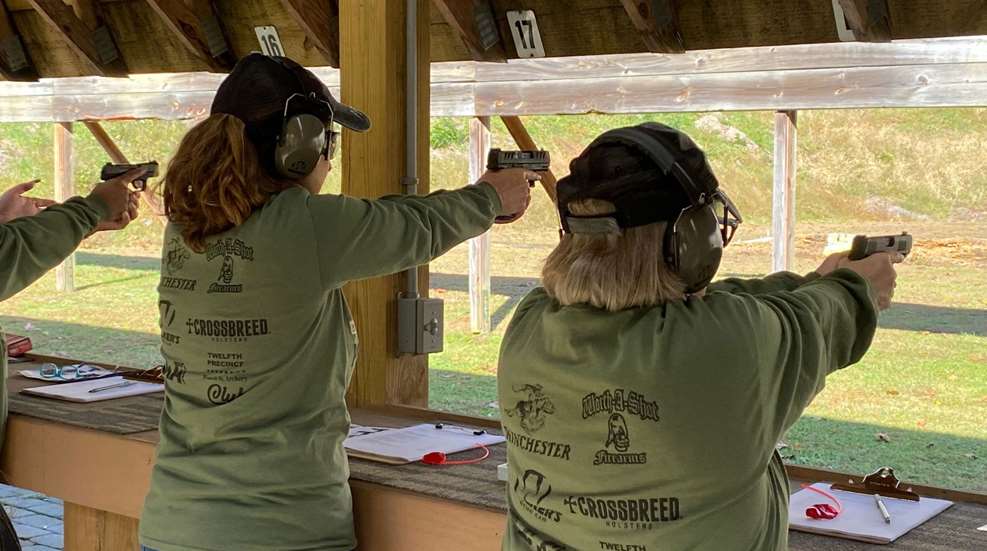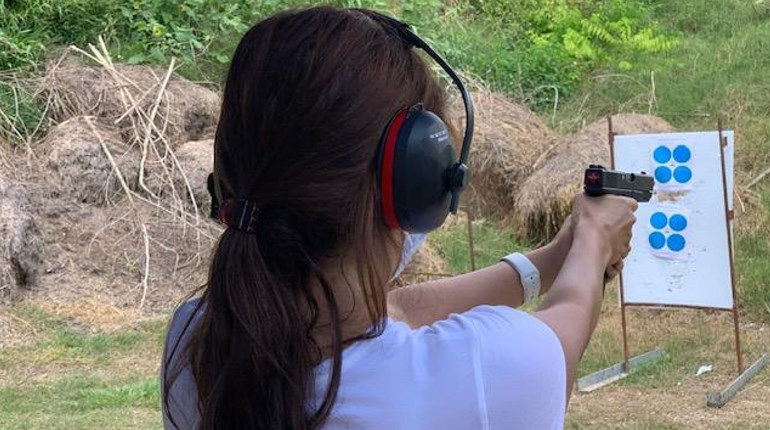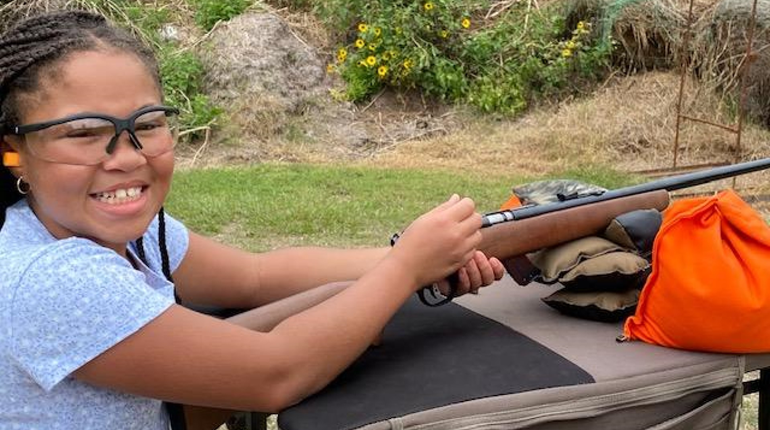
There is no secret to becoming a better shot. All it takes is to practice the 5 Fundamentals of Pistol Shooting: aiming, breath control, hold control, trigger control and follow through. These fundamentals of marksmanship determine whether you hit your target.
Sometimes just knowing and following the basics is not enough. There are things that you can do to help bring the 5 Fundamentals of Pistol Shooting together. These include shooting under your dominant eye; using a smaller caliber firearm; using a blank target; and bring your target closer.
1. Shoot Under Your Dominant Eye
One of the biggest issues with shooters who are cross-eye dominant is failing to shoot under the dominant eye. This means that the shooter is either right-handed and left-eye dominant, or the shooter is left-handed and right eye dominant. Every shooter should do an eye dominance test on their own or have another individual who knows how to conduct the test perform one on him or her.

There is a false and prevalent belief that you can shoot a handgun just as well if you are lined up on your target, under the non-dominate eye. Many believe that all they must do when shooting a pistol or revolver with the hand under the non-dominate eye, is to shift your arms and hold your firearm on target under their dominate eye. This oftentimes happens if the shooter has never been taught about eye dominance and is only shooting with their dominant hand, or if they have never been properly instructed during a shooting lesson or in a firearms class.

I frequently have cross-dominant students in my classes who have only learned about it during the basic pistol class. Almost none of my cross-dominant students, especially those who are right-handed and left-eye dominant, have never shot with their hand holding their firearm under their dominate eye. I make them switch hands, placing the firearm in the hand under their dominant eye, and shoot. Most of them do so reluctantly because it is something they have never done and feels a bit awkward. But they soon find out they can shoot much better! It is simple: You will never shoot as good as you can until you shoot from the hand under your dominant eye.

2. Small Caliber
Small caliber firearms are key to the ultimate success of shooters. Ask any proficient shooter and he or she will tell you the value of utilizing a .22-cal. handgun to perfect marksmanship skills. Unfortunately, many shooters think small-caliber firearms are “beneath” them. They feel that if they shoot anything less than their favorite (larger) caliber, it is a waste of time. Vanity is often the culprit that prevents many shooters from practicing with small-caliber firearms.
Using a small-caliber firearm allows the shooter to concentrate on the 5 Fundamentals of Pistol Shooting. It also helps the shooter identify which one or more fundamentals are causing accuracy problems. Another benefit is that smaller caliber ammunition is inexpensive to shoot, so the shooter can really concentrate on proficiency as opposed to the cost of training with a larger caliber. Practicing the fundamentals with small caliber firearms transfers and applies very well to the shooter’s preferred caliber and preferred firearm.
Small-caliber firearms, especially .22s, can be a game-changer for someone who is struggling with their marksmanship. Small-caliber firearms can help eliminate flinching or any other issues resulting from fear or apprehension of larger calibers. Because of accuracy and ease of operation, the .22 LR caliber is quickly becoming the self-defense choice for many individuals who are looking for self-protection but may not go to the range very often. In fact, many states allow their concealed-carry or open carry qualifications to be done with a .22-cal. firearm. Afterall, a small caliber firearm carried for protection is better than having no firearm at all.

3. Blank Target
Blank targets are one of the best tools to get a shot grouping from a student who is having a hard time consistently hitting a ringed or bullseye target. Simply take a clean ringed target and turn it over to the blank side, and darken a small circle in the center of the page. Using the darkened circle as an aiming point, the shooter is usually able to get a grouping. It is important to remember that the shooter must aim at the darkened circle each time, and not chase his or her shots trying to adjust or compensate with the next shot. The grouping may not be the tightest, but it is a grouping compared to what the shooter had before.
There is something about a standard ringed target that is psychologically intimidating to many new shooters. The rings can be a distraction with each ring’s numerical value and the “X” ring in the center. This is because we all want to get the highest score we can, trying to place all shots within the “X” ring. By using a blank target, the pressure of the “X” ring and getting a high score is eliminated.
Using a blank target also removes a false sense of marksmanship. I see this in many of my classes. For example, whenever we use a standard ringed or bullseye target a student may have a defined grouping somewhere on the target other than near the center of the target. They might “throw” one shot that hits the “X” ring. The shooter always seems to get excited over the one shot in the “X” ring but ignores the consistent grouping he or she may have elsewhere on the target. It is the grouping that measures marksmanship, not the one “X” shot.
4. Close Target
If a shooter is not showing proficiency with a firearm at a certain distance, he or she should reduce the distance to the target. Mistakes are amplified the further you are away from the target. Therefore, to isolate the fundamental that is causing issue, a close target can quickly identify the problem. The NRA Basic Pistol Course curriculum states the Level 1 distance for a new shooter is 10 feet.
The average self-defense distance when firearms are used is 7 yards (21 feet) or less. Yet, when you see shooters struggling with accuracy at the range, it is not uncommon to see them shooting at 15 yards or more. Once again, vanity is usually the culprit in regard to practicing at close distances. Many of these shooters look at distances of 7 yards or less as an avid snow skier would look at the “bunny slope.”
A close target usually is accompanied by success. There is a saying, “Aim small, Miss small.” This can be applied to having a close target. By focusing on targets 3 to 7 yards, the shooter can hone his or her skills to master that distance. Only then can further distances be shot with proficiency. Remember—you must crawl before you can walk before you can run!
By using these range tips, you can quickly start achieving your goals on the range. It is always good to remember the basics when training and learning a skill, always progressing from the simple to complex. Make sure you have a solid foundation to build upon and improve marksmanship. It is often said that practice makes perfect. In reality, perfect practice makes perfect!














































